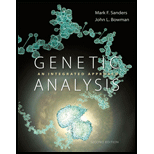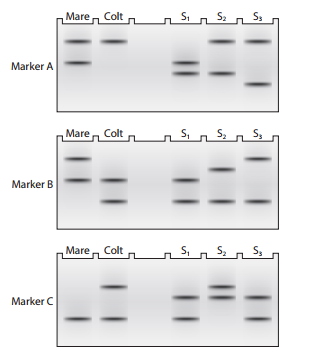
Genetic Analysis: An Integrated Approach (2nd Edition)
2nd Edition
ISBN: 9780321948908
Author: Mark F. Sanders, John L. Bowman
Publisher: PEARSON
expand_more
expand_more
format_list_bulleted
Textbook Question
Chapter 7, Problem 33P
Three independently assorting VNTR markers are used to assess the paternity of a colt (C) recently born to a quarter horse mare (M). Blood samples are drawn from the mare, her colt, and three possible male sires (

Evaluate the data and determine if any of the potential sires can be excluded. Explain the basis of exclusion, if any, in each case.
Expert Solution & Answer
Want to see the full answer?
Check out a sample textbook solution
Students have asked these similar questions
In a paternity suit, a woman with type O blood claims that a man with type AB blood is the father of her type O baby. List the genetypes of the mom, man, and baby. Can the woman prove he is the father or can he is not? Why or why not? If the accused man was type A insyead of type AB, what would be his possible genotypes? Could the woman prove he is the father? Can the man prove he is not the father? Why or why not?
A RFLP is discovered that is linked to the gene for Duchenne’s muscular dystrophy (DMD). DMD is an X-linked, recessive trait. The RFLP is 2 map units from the gene for DMD. Consider the following pedigree and Southern blot using a probe that hybridizes to the RFLP.
Which band/s is/are associated with DMD?
What is the genotype for individuals 3 and 4? (Remember, this is an X linked disease, so use X’s and Y’s to denote).
Individual 9 married a man who does NOT have muscular dystrophy, and she is pregnant. DMD is an X-linked trait. What is the probability for their child to have DMD?
An amniocentesis is performed and it is determined that 9’s child in utero has only a 10 kb band that hybridizes to the same probe used above. What can you say about the child now?
Consider the first category of test-cross offspring shown in figure 8.2 (+b, LS). Consider also that the parents of the heterozygous female flies in the test cross had the following genotypes: bb, SS, and +, LL.
A. What would be the physical phenotype of these flies?
B. If PCR was conducted with the DNA of one of these flies using the primers for the molecular marker, what would be the appearance of the bands on an electrophoresis gel with the PCR products?
C. If the gene for black body and the locus for the molecular marker (L long or S short) were unlinked, what proportion of the test-cross progeny would be black flies that are heterozygous for the molecular marker? What proportion would be flies with normal body color, which are homozygous for one form of the molecular marker?
D. If the gene for black body and the locus for the molecular marker were linked, how would the proportion of flies be different?
Chapter 7 Solutions
Genetic Analysis: An Integrated Approach (2nd Edition)
Ch. 7 - What results from the experiments of Frederick...Ch. 7 - 7.2 Explain why Avery, MacLeod, and McCarty’s in...Ch. 7 - 7.3 Hershey and Chase selected the bacteriophage...Ch. 7 - 7.4 Explain how the Hershey and Chase experiment...Ch. 7 - 7.5 One strand of a fragment of duplex DNA has the...Ch. 7 - 7.6 The principles of complementary base pairing...Ch. 7 - For the following fragment of DNA, determine the...Ch. 7 - 7.8 Figures present simplified depictions of...Ch. 7 - 7.9 Consider the sequence -ACGCTACGTC-.
What is...Ch. 7 - DNA polymerase III is the main DNA-synthesizing...
Ch. 7 - Explain how RNA participates in DNA replication.Ch. 7 - A sample of double-stranded DNA is found to...Ch. 7 - Bacterial DNA polymerase I and DNA polymerase III...Ch. 7 - Diagram a replication fork in bacterial DNA and...Ch. 7 - Prob. 16PCh. 7 - Which of the following equalities is not true for...Ch. 7 - List the order in which the following proteins and...Ch. 7 - Two viral genomes are sequenced, and the following...Ch. 7 - Matthew Meselson and Franklin Stahl demonstrated...Ch. 7 - Raymond Rodriguez and colleagues demonstrated...Ch. 7 - 7.22 Joel Huberman and Arthur Riggs used pulse...Ch. 7 - 7.23 Why do the genomes of eukaryotes, such as...Ch. 7 - Bloom syndrome (OMIM 210900) is an autosomal...Ch. 7 - 7.25 How does rolling circle replication (see...Ch. 7 - Telomeres are found at the ends of eukaryotic...Ch. 7 - A family consisting of a mother (I-1), a father...Ch. 7 - In a dideoxy DNA sequencing experiment, four...Ch. 7 - Prob. 29PCh. 7 - Using an illustration style and labeling similar...Ch. 7 - A PCR reaction begins with one double-stranded...Ch. 7 - Prob. 32PCh. 7 - Three independently assorting VNTR markers are...Ch. 7 - 7.34 A sufficient amount of a small DNA fragment...Ch. 7 - Prob. 35P
Knowledge Booster
Learn more about
Need a deep-dive on the concept behind this application? Look no further. Learn more about this topic, biology and related others by exploring similar questions and additional content below.Similar questions
- Pedigree Analysis Is a Basic Method in Human Genetics Using the pedigree provided, answer the following questions. a. Is the proband male or female? b. Is the grandfather of the proband affected? c. How many siblings does the proband have, and where is he or she in the birth order?arrow_forwardPedigree Analysis Is a Basic Method in Human Genetic: What are the reasons that pedigree charts are used?arrow_forwardPedigree Analysis Is a Basic Method in Human Genetic: What does OMIM stand for? What kinds of information are in this database?arrow_forward
- Both karyotyping and G_banding techniques show normal chromosomal pattern, however pedigree analysis revealed abnormality of genetic origin, what are the reasons of this?arrow_forwardConsider the first category of test-cross offspring shown in figure 8.2 (+b, LS). Consider also that the parents of the heterozygous female flies in the test cross had the following genotypes: bb, SS, and +, LL. A. What would be the physical phenotype of these flies? B. If PC was conducted with the DNA of one of these flies using the primers for the molecular marker, what would be the appearance of the bands on an electrophoresis gel with the PC products? C. If the gene for black body and the locus for the molecular marker (L long or S short) were unlinked, what proportion of the test-cross progeny would be black flies that are heterozygous for the molecular marker? What proportion would be flies with normal body color, which are homozygous for one form of the molecular marker? D. If the gene for black body and the locus for the molecular marker were linked, how would the proportion of flies be different?arrow_forwardWhat is the relevance of a Chi-square test in Geneticsarrow_forward
- illustrate several applications of the chi-square test pertinent to genetics.arrow_forwardRefer to the sequence characteristics of the alleles for Gene A (A1 = Allele 1 and A2 = Allele 2) below: Question: What DNA marker system can be developed for Gene A as characterized above, for example to study A-allele diversity? Briefly describe your proposed DNA marker i.e. concept overview, type/frequency/site of DNA mutation, method of resolution, genetic inheritance, etc.arrow_forwardYou have already localized the genes to the same chromosome by deletion mapping, and now decide that the best way to accomplish the mapping is to conduct two simultaneous three-point testcross experiments. The genes you are investigating are as follows: N = round leaves, n = notched leaves; H = smooth stems, h = hairy stems; R = purple flowers, r = red flowers; B = grey seeds, b = black seeds; and Y = green pods, y = yellow pods. Earlier experiments you have done already established that gene B is in the middle of this gene cluster, so you design both three-point test crosses to include that gene. Cross #1 is designed as RrHhBb x rrhhbb while cross #2 is NnBbYy x nnbbyy. The results of both crosses are given in the table below. Based on the information given, determine the arrangement of these five genes including the position of each allele in the heterozygous fly and the distances between each pair of genes. (Hint: treat each experiment separately, knowing that gene B is in the…arrow_forward
- The human IGF2 gene is autosomal and maternally imprinted. Copies of the gene received from the mother are not expressed, but copies received from the father are expressed. You have found two alleles of this gene that encode two different forms of the IGF2 protein distinguishable by gel electrophoresis. One allele encodes a 60K (Kilodalton) blood protein; the other allele encodes a 50K blood protein. In an analysis of blood proteins from a couple named Bill and Joan, you find only the 60K protein in Joan’s blood and only the 50K protein in Bill’s blood. You then look at their children: Jill is producing only the 50K protein, while Bill Jr. is producing only the 60K protein. Draw the possible pedigree. With these data alone, what can you say about the IGF2 genotype of Bill Sr. and Joan? Bill Jr. and a woman named Sara have two children, Pat and Tim. Pat produces only the 60K protein and Tim produces only the 50K protein. With the accumulated data, what can you now say about the…arrow_forwardThe human IGF2 gene is autosomal and maternally imprinted. Copies of the gene received from the mother are not expressed, but copies received from the father are expressed. You have found two alleles of this gene that encode two different forms of the IGF2 protein distinguishable by gel electrophoresis. One allele encodes a 60K (Kilodalton) blood protein; the other allele encodes a 50K blood protein. In an analysis of blood proteins from a couple named Bill and Joan, you find only the 60K protein in Joan’s blood and only the 50K protein in Bill’s blood. You then look at their children: Jill is producing only the 50K protein, while Bill Jr. is producing only the 60K protein. a. Draw the possible pedigree. With these data alone, what can you say about the IGF2 genotype of Bill Sr. and Joan? b.Bill Jr. and a woman named Sara have two children, Pat and Tim. Pat produces only the 60K protein and Tim produces only the 50K protein. With the accumulated data, what can you now say about the…arrow_forwardAssume that you are working as an expert of karyotype analysis in a Genetics Laboratory. You are using G-Banding for staining to chromosomes. Explain briefly the steps of karyotype analysis from blood samples.arrow_forward
arrow_back_ios
SEE MORE QUESTIONS
arrow_forward_ios
Recommended textbooks for you
 Human Heredity: Principles and Issues (MindTap Co...BiologyISBN:9781305251052Author:Michael CummingsPublisher:Cengage Learning
Human Heredity: Principles and Issues (MindTap Co...BiologyISBN:9781305251052Author:Michael CummingsPublisher:Cengage Learning

Human Heredity: Principles and Issues (MindTap Co...
Biology
ISBN:9781305251052
Author:Michael Cummings
Publisher:Cengage Learning
DNA Use In Forensic Science; Author: DeBacco University;https://www.youtube.com/watch?v=2YIG3lUP-74;License: Standard YouTube License, CC-BY
Analysing forensic evidence | The Laboratory; Author: Wellcome Collection;https://www.youtube.com/watch?v=68Y-OamcTJ8;License: Standard YouTube License, CC-BY